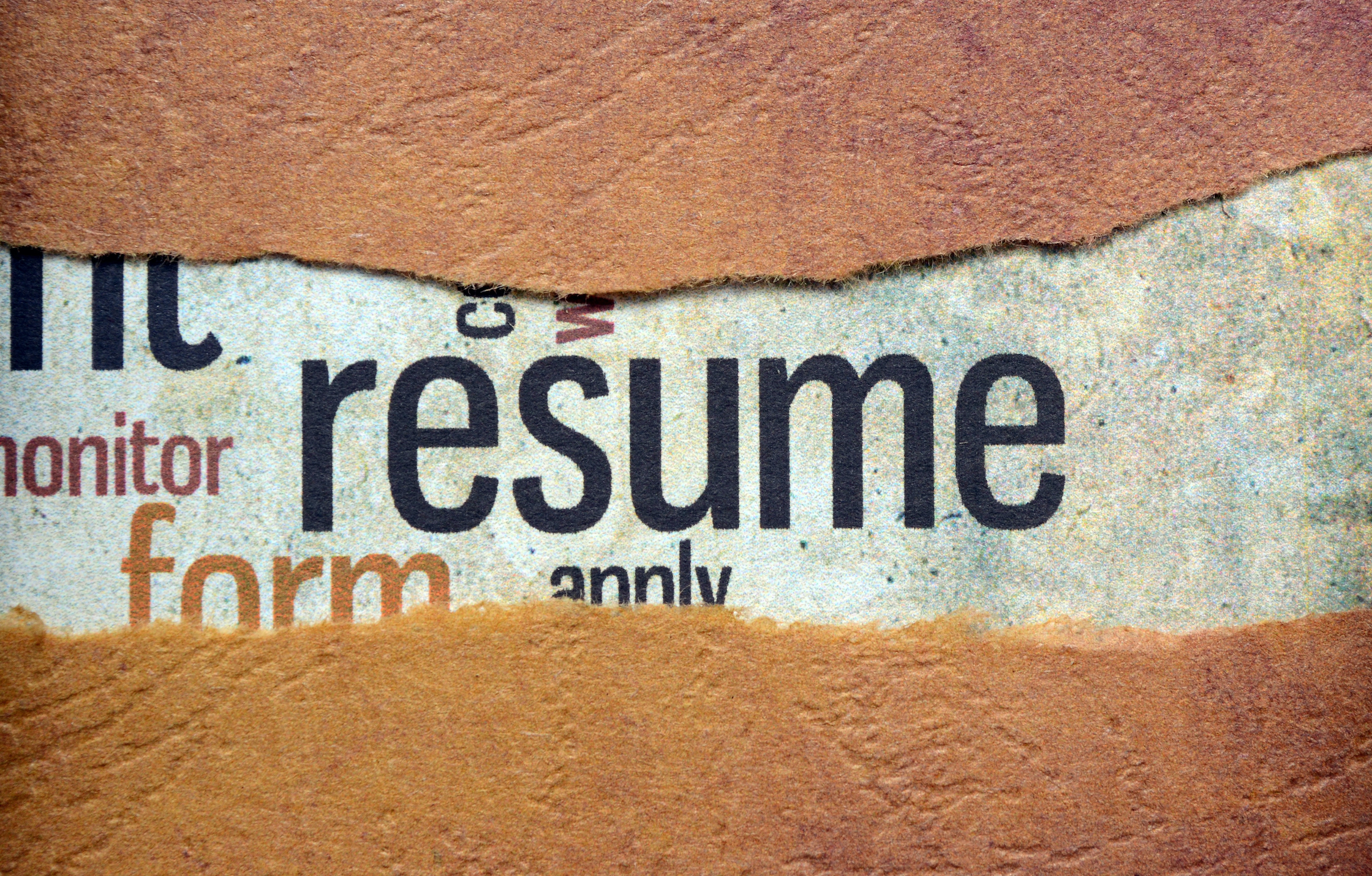Types of Resumes
One of the most unsung differences between the film & video industry and most other career paths is how resumes are formatted and presented. Since this is a visual medium–and most professionals have had at least some freelance experience that isn’t considered a ‘typical’ job–our industry resumes can look quite different.
And to top that off, each job within the video industry will have different expectations for how your resume should look. For example, a graphic designer’s resume will look much different than a corporate producer’s resume, and that will differ from a freelance DP’s resume.
In general, there are 4 types of resumes you can choose from.
- Professional Experience Resume – This is, essentially, a ‘traditional’ resume. It lists jobs you’ve held in the past, the responsibilities contained within, starts with an Objective statement and is easy for big corporate A.I. resume readers to auto-read. These resumes are typical for bigger production companies or corporations looking to hire ‘producers’ or ‘videographers’ in-house.
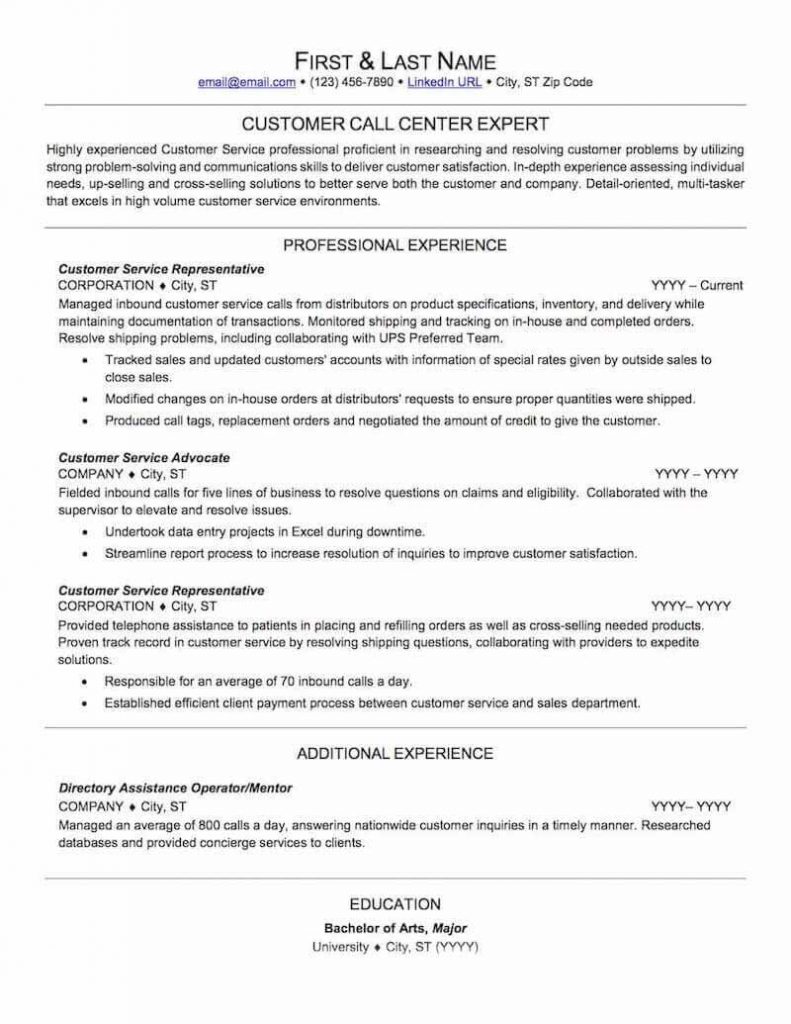
2. Credits Resume – Ever seen an acting resume? This is the same idea; list your professional credits and other pertinent information such as training, education, and awards. Typically used for jobs hiring professionals on a project-by-project basis or specific, dedicated positions such as DPs or Directors. This is the type of resume used in the film/television crew world, where they want to hire people with experience in certain positions. A showrunner has no need to see a traditional resume for a PA, they just want to know you’ve been on set and can do the job. Your credits do the talking for you.
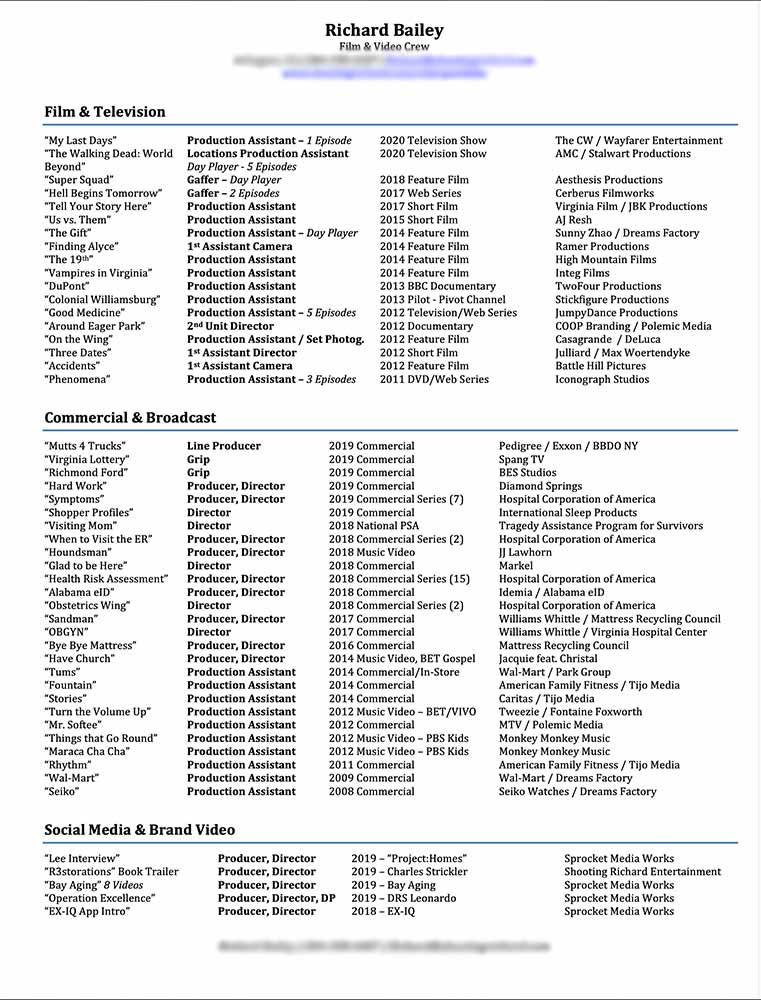
3. Hybrid Resume – Combines aspects of the Professional Experience resume along with a list of credits. Typically used by folks who’ve held traditional “jobs” but also have impressive credits or projects they’ve worked on, such as if you were an in-house DP for a number of years, but also filmed 2 feature films outside of your “day job.” If you’re fancy, you may hear this referred to as your Curriculum Vitae or CV.
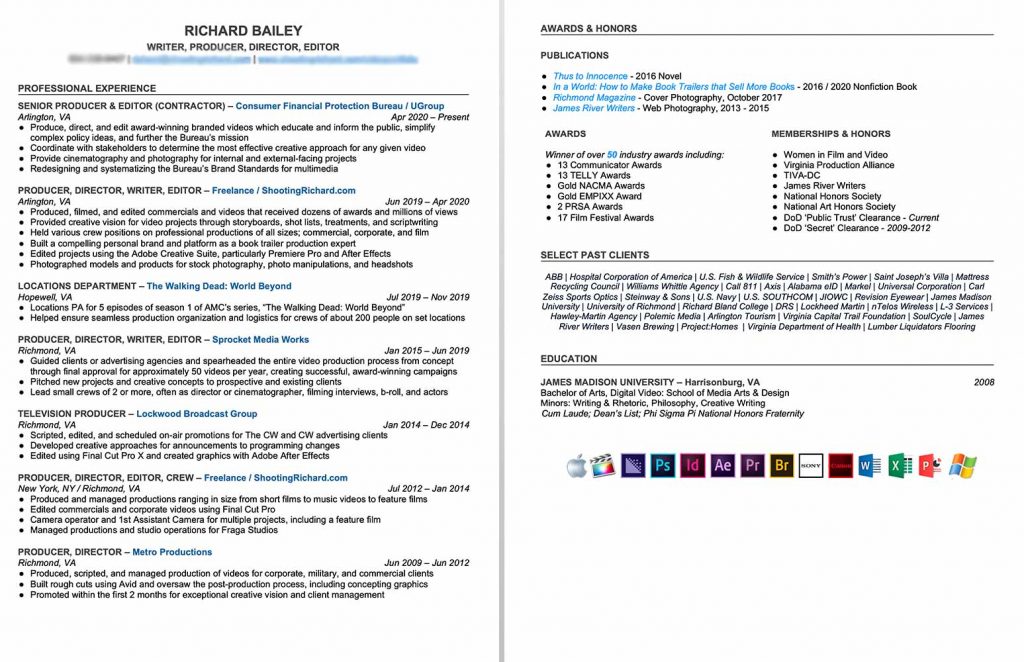
4. Infographic Resume – Essentially, these highly-art-directed resumes contain all the relevant information, but in a more graphical style. This style was en vogue for a while, but may have fallen off with the dawn of A.I. resume readers. Production companies and advertising agencies may prefer these very visual resumes, especially from art directors, graphic designers, or other creatives. They may also dismiss these types of resumes as they often have meaningless “information,” such as skill level meters that don’t have clear metrics. Below, you’ll see this guy’s resume is cool to look at, but his skills are listed as a percentage. But a percentage of what? Get to know the agency you’re applying to if you’re going to be taking a risk like this.
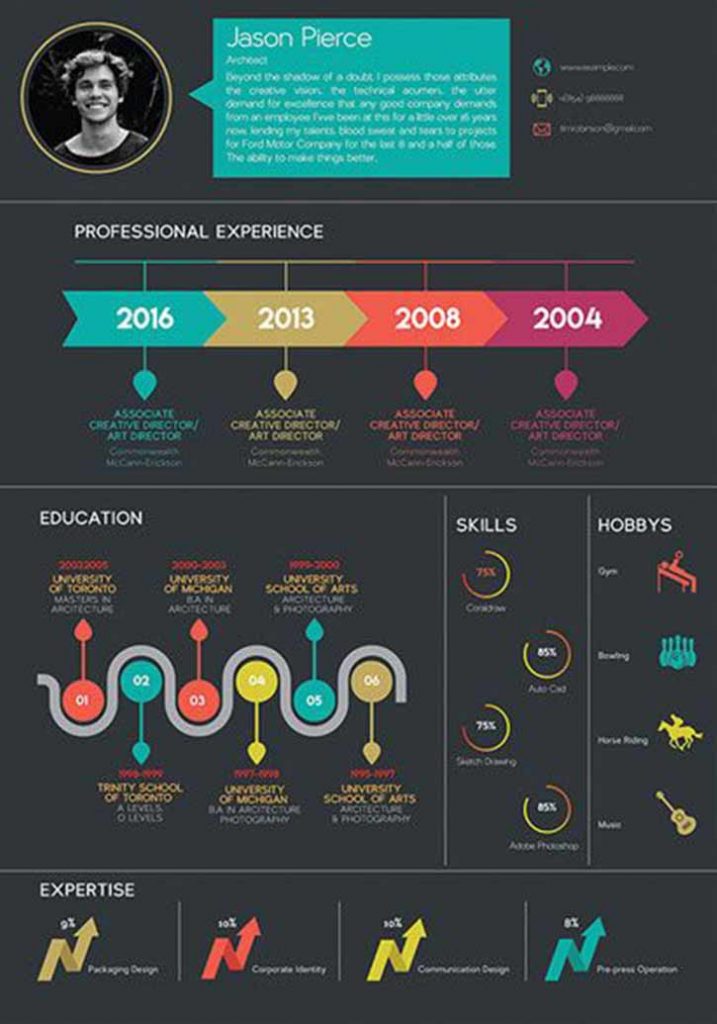
To know what’s best for you, research successful resumes by simply searching for images or templates of resumes for your job title. Understand the company culture and position you’re applying to. Some may be more open to unique resumes, some may prefer traditional formatting.
The film & video industry is the most competitive industry in the world. As such, it has one of the highest application rates for any particular job, so you want to make sure your resume stands out and is easy to read quickly.
This is a necessary evil within the industry. Most any job worth its salt will have hundreds if not thousands of applications and resumes sent in for it. Hiring managers or producers (or their assistants) have to weed through all of these resumes to pick the top contenders. In order to make the cut, you want to make sure you’re easy to find and that you stick out–in a good way. Your cover letter and resume are the first chance to do that. So it behooves you do work hard on your resume.
Tips for Film Resumes
In addition to what type of resume you choose, here are some quick tips for keeping your resume up to snuff. I am no self-help resume guru, but here are some refreshers.
- Customize your resume to the job you want. This means changing your title to reflect the job title, and organizing your resume in such a way that the most relevant stuff is easiest to find.
- “Everything must fit on one page” is a guideline, not a law. If you’ve been in an industry long enough, you can go to a second page. Just so long as the work is relevant and easy to read.
- Make sure your contact info is easy to find.
- Make sure your website / reel / portfolio is hyperlinked in the document and easy to find. This is likely the most important part of your application.
- Some folks like a “Summary” or an “Objective.” Some don’t. But if you do have an Objective statement, make sure it is quick, original, to the point, specific, and says what you want to do, not just what you have done.
- Make it easy to read. No matter how much information you have to get across, it shouldn’t look too dense or complex. This means avoiding huge blocks of text, unbalanced white space, or headings and descriptions that are impossible to discern. Imagine someone with a migraine and blurred vision is reading your resume. You want to make it as easy as possible for them to spot the important stuff.
- Every job or experience should show why it makes you a good candidate. Some jobs are self-evident (DP credits don’t need an explanation of why they’re relevant to a DP job), but others are not so obvious to employers. Make sure your descriptions show off your skillset and accomplishments with specifics.
- If you’re a student, be aware that ‘relevant coursework’ is usually meaningless to employers without context. If all you have is class projects, your reel/portfolio better be absolute gold.
- Get rid of outdated or irrelevant jobs. Unless you did something really exceptional for the business, it’s unlikely your experience slinging hot dogs in high school is relevant to your current career path.
- Make sure your resume is organized and easy to follow. This also includes grouping similar credits or experiences together. Mixing acting gigs with behind-the-camera gigs is hard for an employer to quickly parse through.
- Show don’t tell. Each entry on your resume should show results and skills rather than just telling the reader that you did a thing. Show us why it’s important with examples, numbers, specifics, and how your contribution was important to that job overall.
- Make sure your tense (past, present, pluperfect, whatever) is consistent. Past tense for past jobs, present tense for current job.
- Education isn’t usually that important in this field, so you may consider de-emphasizing your education in favor of experience. In particular, your GPA doesn’t usually mean much (unless it’s super impressive). It’s usually best to stick with your school, degree, and year you graduated.
- Make sure your section headings make sense and are easy to understand. I personally have “Professional Experience”, “Honors & Awards”, “Select Past Clients (or credits)”, and “Education.” Some people have “Professional Experience” and “Related Experience” to differentiate jobs vs. gigs.
- Pay attention to the dates on your resume and ensure there’s no huge, unexplained gap in employment.
- If you have any awards or professional memberships, you may want a very brief section for that as well. If not, then skip it.
- Make sure your fonts, font sizes, headings, bullet points, and other formatting options are consistent and easy to read. This is surprisingly important because we’re in a visual industry and your resume should show off how well you can organize information.
- Make sure your grammar and spelling is perfect. Missing apostrophes and misused “to” vs. “too” details will kill you. If you can’t pay attention to details on one or two resume pages, how can you be expected to be detail-oriented on the job?
- Do your research. There are thousands of resources that will help you create, edit, and format a resume properly. Most of those resources are free and stupid easy to find. Use what’s available to you because so many people don’t.
- ***Always, always, ALWAYS export your resume to a PDF format, NOT a Word, OpenOffice, or Google document. PDF is the only universal document format. If you provide a Word document, often the formatting gets really screwed up.***
Don’t Forget to Cover Your Assets
Although your Demo Reel and/or Portfolio is the most important part of getting a job in the industry, getting an employer to look at your portfolio can be tricky. That’s where a Cover Letter comes in.
I won’t go into a lot about cover letters because, as previously mentioned, I am not an employment expert. BUT they are extremely important and there are a few things you need to know before just shooting your resume off into the void unaccompanied.
First, always send a cover letter. Even if it’s just a sentence or two in an email saying why you’re contacting the person. I don’t know how many emails I’ve received with applicants just attaching their resume without a word on who they are or what they want. A stranger expects me to blindly open an attachment when they haven’t told me why they’re emailing me? I’ll take my coffee without a computer virus, thank you very much.
In a very basic sense, a cover letter is a short introduction to you, whether in the body of the email or as part of a job application. It accomplishes a lot, so don’t skip it. First, it makes the employer aware of why you’re contacting them. You want to be sure to mention, very quickly, that you’re interested in the job posting and that’s why you’re contacting them.
The cover letter also allows you to pitch your reel/website/portfolio right up front. Maybe the employer doesn’t even want to look at your resume. But they do want to see your work if they’re going to hire you.
A cover letter also gives an employer an insight into how professional you are, gives some context to the items they’ll see on a resume, and shows them a bit about what your personality is like–which is vital if they’re serious about hiring a person who fits with the company. It’s your chance to tell your own story in your own words and butter up the employer with praise so they’re primed to like your work/resume. It also shows that you’re serious about this specific job, rather than just shooting out resumes into the void and hoping one’ll stick.
To make a good first impression, keep the cover letter short (2-ish paragraphs), professional, to-the-point, and approachable. Make sure your letter is formatted like a real adult wrote it, and pay attention to your word choice and tone. Avoid meaningless cliches like “experienced” or “highly skilled,” but rather focus on results; what impact have you had through your work?
Let the employer know you’ve done your research and are interested in this job specifically and what appeals to you about the job. Also, if you’re really smart, slip in what you bring to the table; how will you solve the employer’s problems? How will you make their lives and jobs easier? Because that’s ultimately why they’re hiring.
And end with a salutation and signature that feel encouraging, energetic, approachable, and of course informative. Don’t forget to leave your contact information in the signature.
The most important part about searching for a job in any industry is to do your homework. Know the industry, what’s important, and what they’re looking for. Being resourceful enough to research a potential job is a skill all on its own, and formatting your resume, reel, and cover letter in such a way that shows you know your stuff will help you rise above the pack. Just remember once you’ve gotten an employer’s attention, make sure you can impress them with your work.
Because at the end of the day, it’s all about creating. Everything else is secondary.

